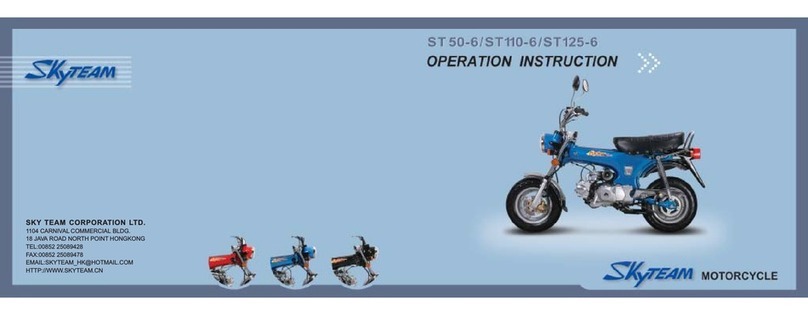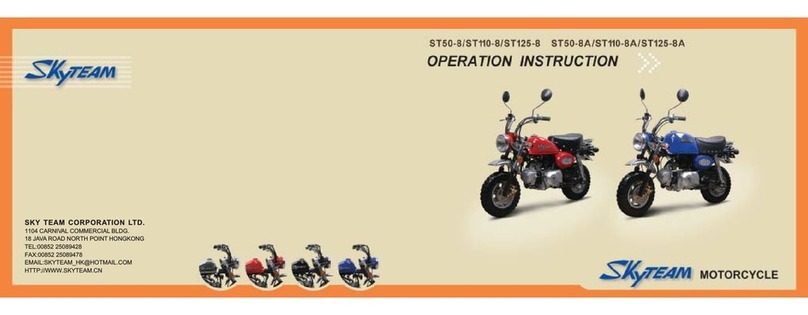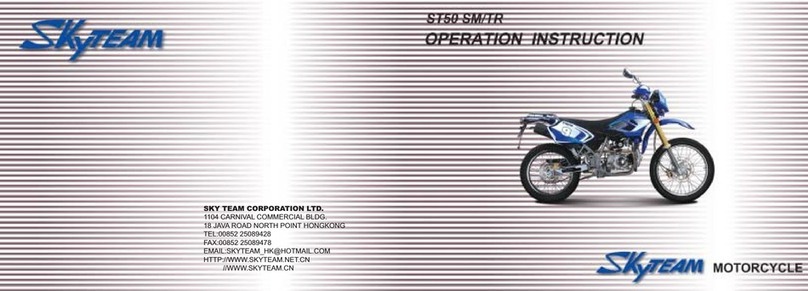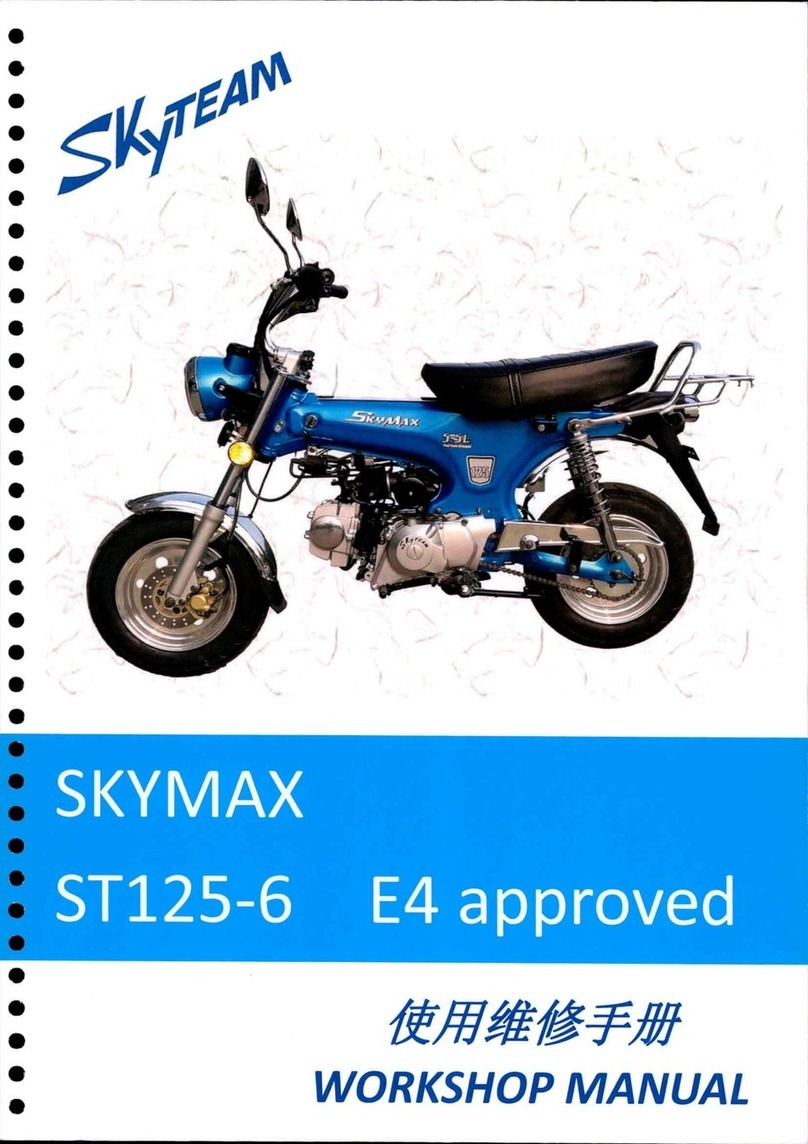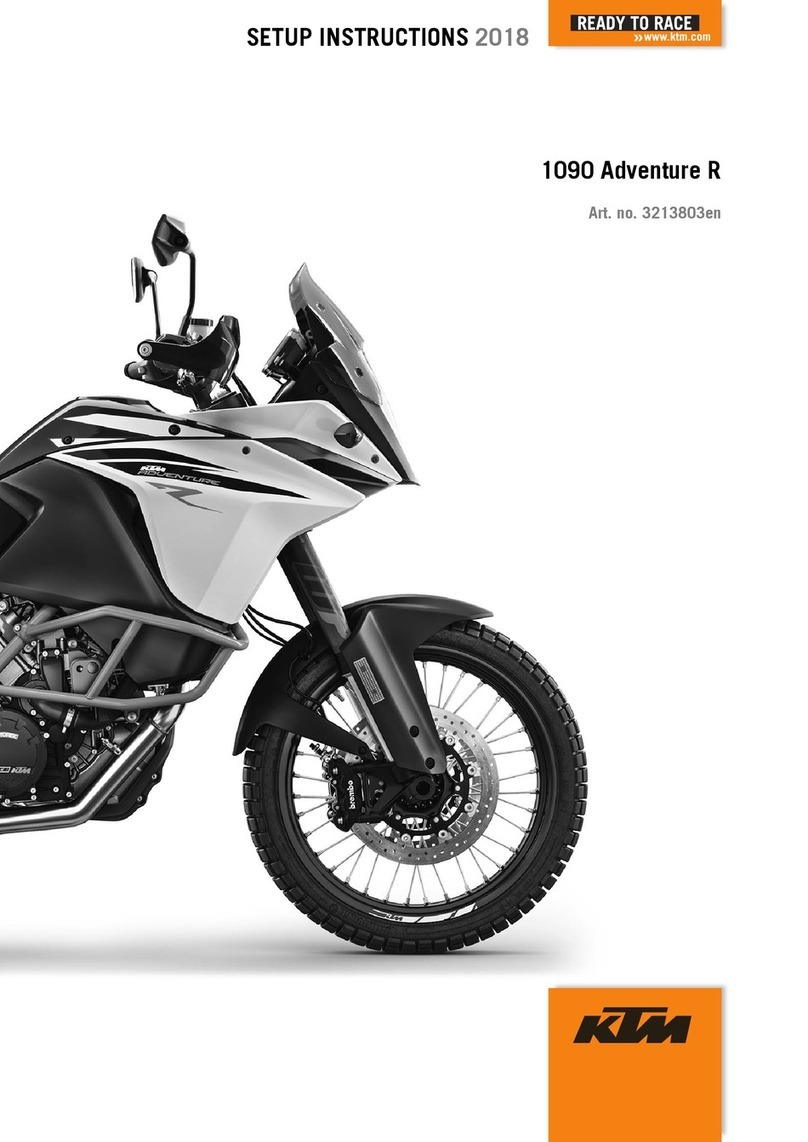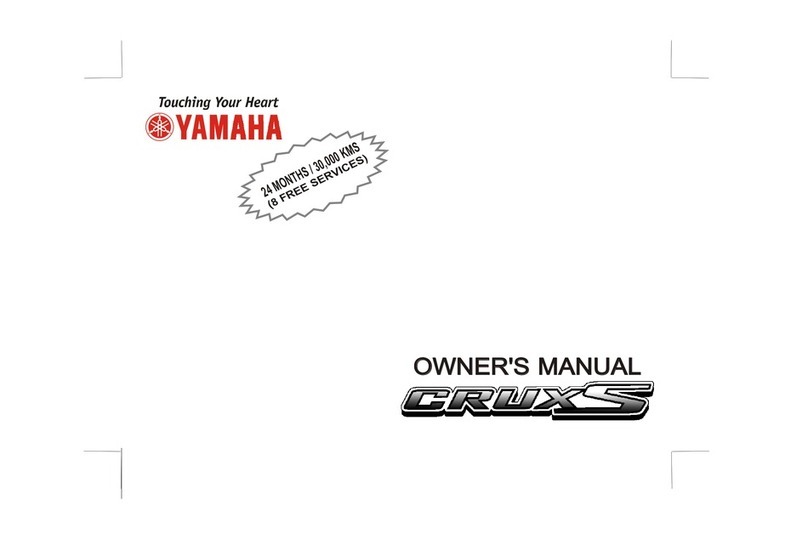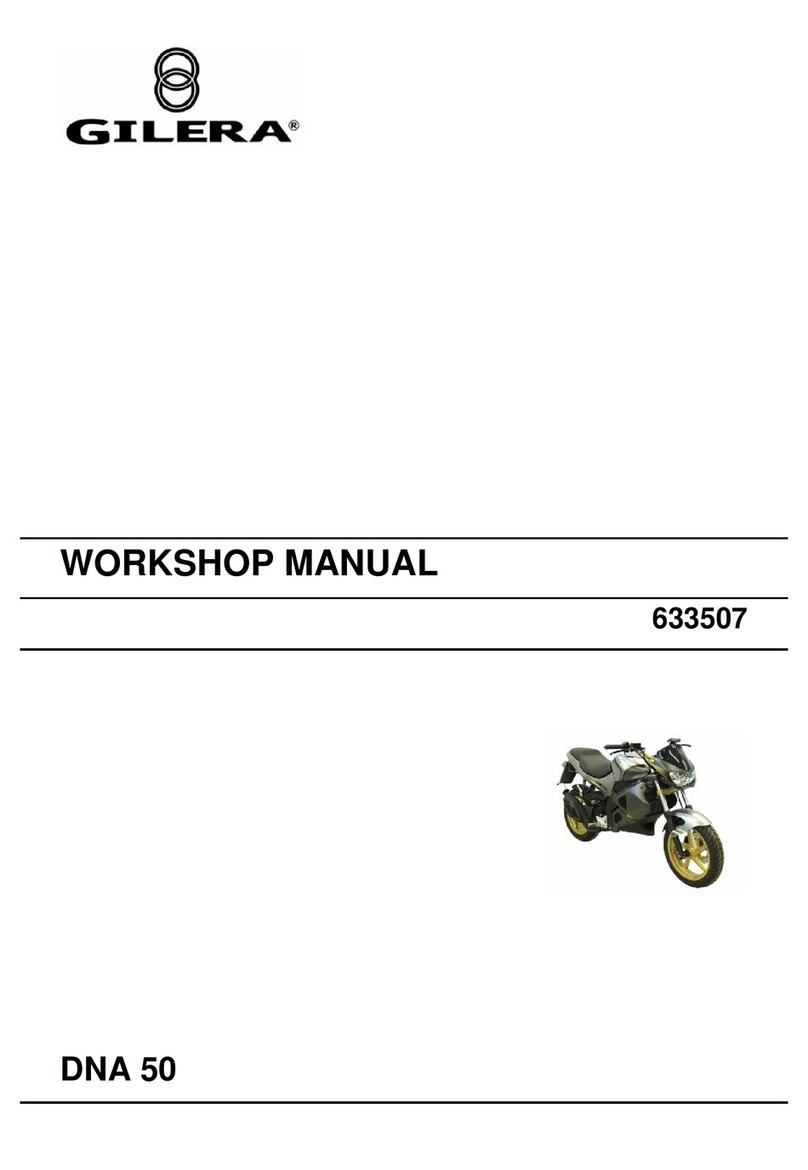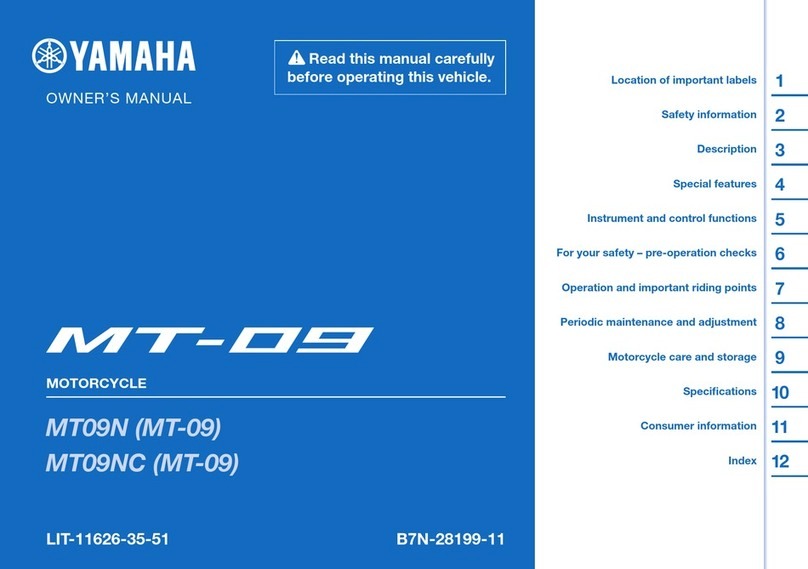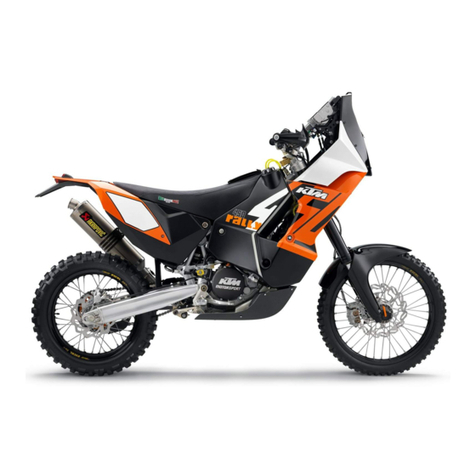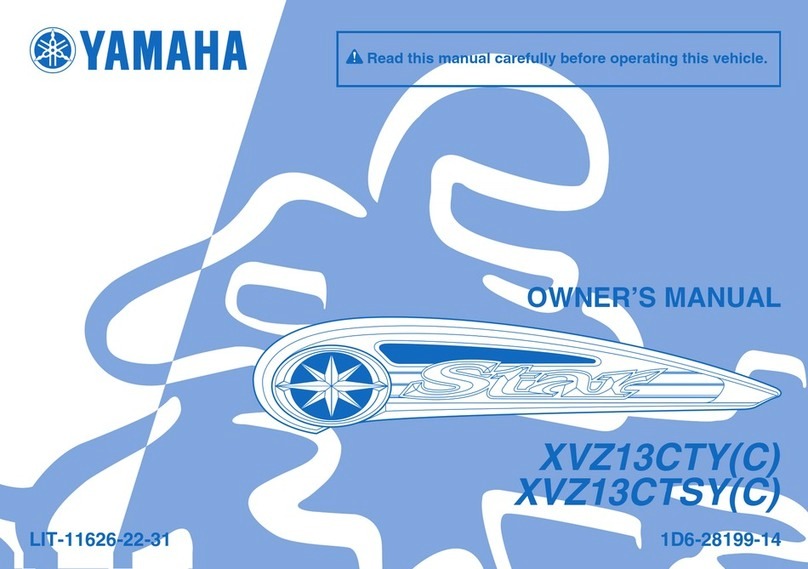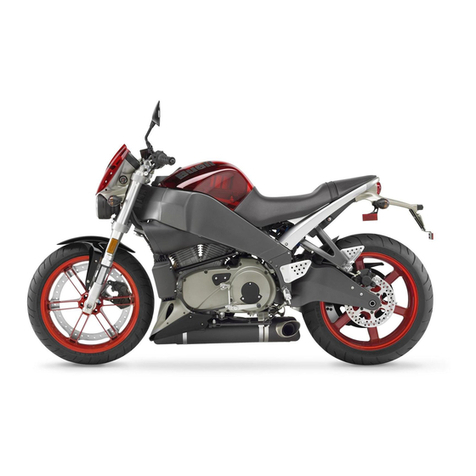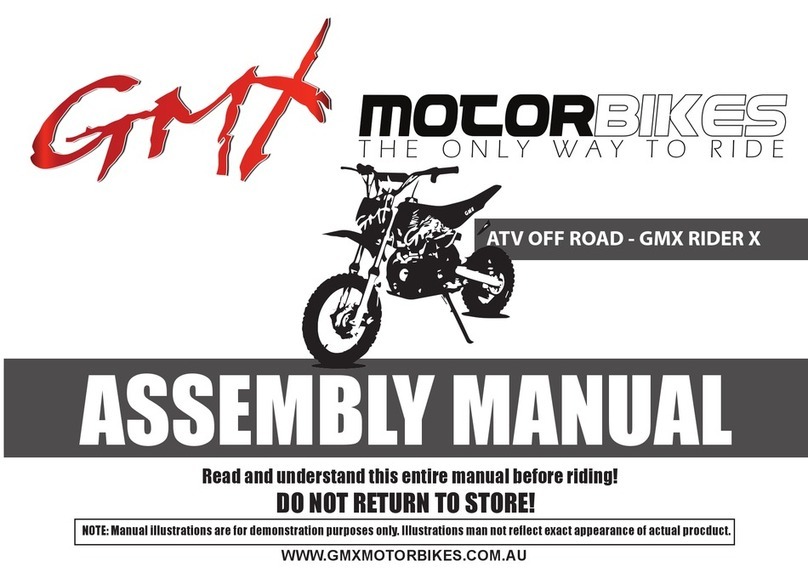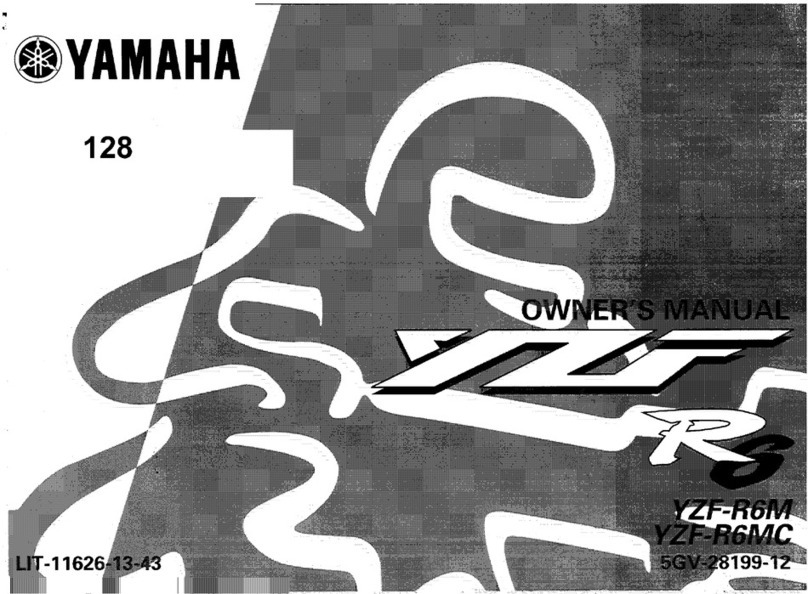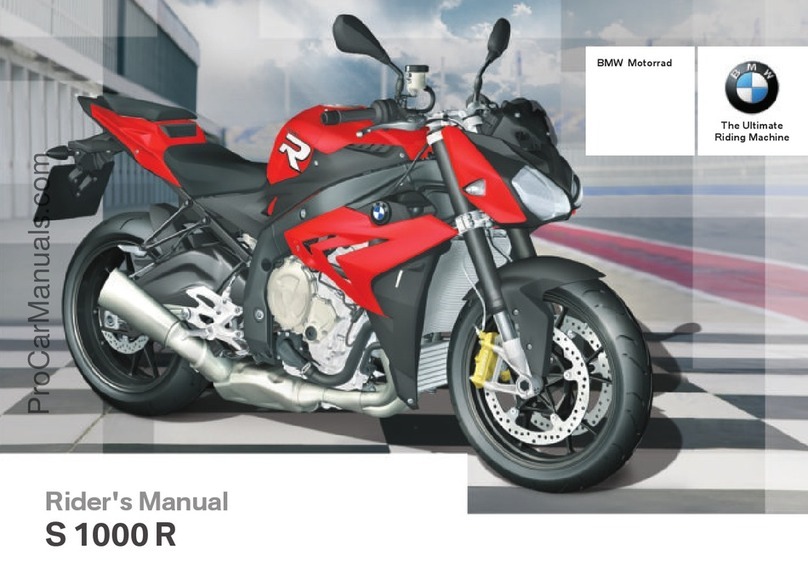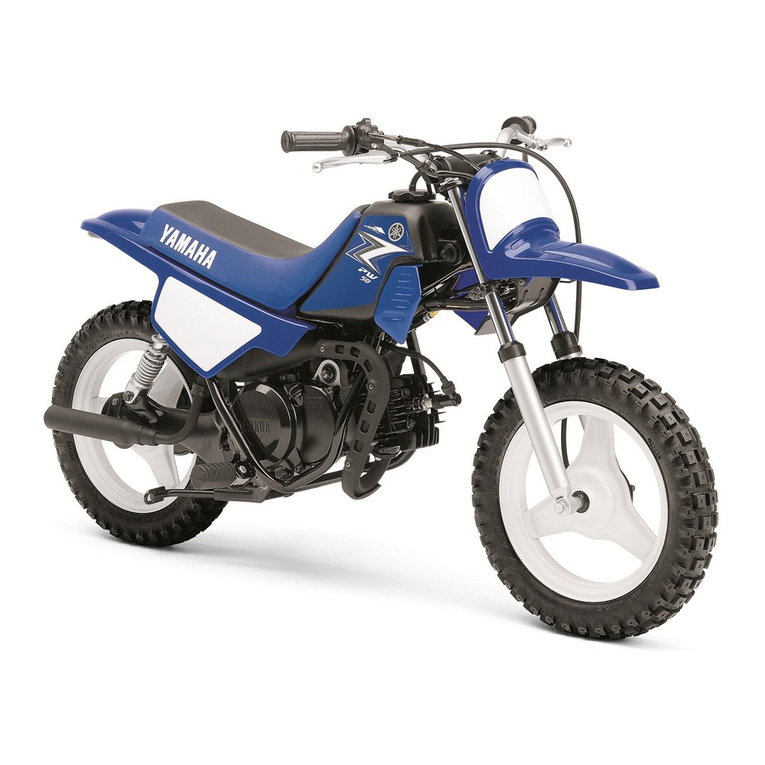Skyteam ST50 Technical manual

SKY TEAM CORPORATION LTD.
1104 CARNIVAL COMMERCIAL BLDG.
18 JAVA ROAD NORTH POINT HONGKONG
TEL:00852 25089428
FAX:00852 25089478
EMAIL:[email protected]
HTTP:// WWW.SKYTEAM.CN

Important precautions
Consumer information
Component locations
Controls
Key
Ignition switch
Instrument panel
Left handlebar
Right handlebar
Fuel tank cap
Fuel cock
Kick starter lever
Rear brake pedal
Gear shift lever
Steering lock
Helmet holder
Fuel and engine oil recommendation
Running-in
Inspection before riding
Riding tips
TABLE OF CONTENTS
Starting the engine
Starting off
Driving on slope
Braking and parking
Checks and maintenance
Periodic maintenance chart
Lubrication
Battery
Air cleaner
Spark plug
Transmission oil
Carburetor
Throttle cable adjustment
Drive chain
Brakes
Tires
Change of Bulb
Troubleshooting
Specifications
1
2
8
11
11
11
11
12
13
14
14
15
15
16
16
17
18
18
20
21
21
22
23
23
24
26
28
28
29
31
31
32
33
34
36
40
41
41
43

BREAK-IN INFORMATION FOR YOUR MOTORCYCLE
The fist 1,600km is the most important in the life of your motorcycle. Proper running - in operation during
this time will help ensure maximum life and performance of your new motorcycle.
Motorcycle reliability and performance depend on special care and restraint exercised during running-in
period. It is important that you avoid operating the engine in the manner which could expose the engine parts to
excessive heat.
Please refer to the "running-in" section for specific running - in recommendation.
Please read this manual and following its instructions carefully.
To emphasize special information, the words WARNING, CAUTION and NOTE carry special meaning and
should be carefully reviewed.
IMPORTANT PRECAUTIONS
WARNING:
CAUTION:
NOTE:
The personal safety of the rider may be involved, disregarding this information could result in
injury to the rider.
These instructions point out special service procedures or precautions that must be followed
to avoid damaging the machine.
These provide special information to make maintenance easier or important instructions clearer.
1
CONSUMER INFORMATION
ACCESSORY INSTALLATION AND
SAFETY PRECAUTION TIPS
There are great varieties of accessories available to
Skyteam owners. The addition of unsuitable
accessories can lead to unsafe operation conditions.
For proper installation of accessories, we have laid
down some principles which will help you for the
correct choice and installation of accessories.
(1)If you want to install a accessory which will result
in a extra weight or a aerodynamic effect to your
motorcycle, try to install it as low as possible and as
close as possible to the center of gravity of your
motorcycle. Check carefully the holder for installing
accessories to make sure for its firmness. The infirm
installation will lead to unstable and dangerous
conditions due to weight deviation.
(2)Check the net clearance and turning angle to make
sure that they are adequate. The improper load, which
may occurs after installing accessories, will very likely
lower their safety factors, Checks should also be made
that this improper load will not hinder the idling, tuning
and other control actions.
(3)Fixing the accessories on handlebars or front fork
will result in unstable operation. This extra weight will
reduce the maneuverability of your motorcycle during
turning operations, meanwhile, this extra weight will
also cause unstable condition due to vibration at the
front end. Therefore, fixing accessories on handlebars
or front fork should be minimized.
(4)Things like wind glass, windshield, waist support,
bags across seat and suitcases all have a aerodynamic
effect on the stability of your motorcycle, when there
is a side wind or large vehicles passing by. The
improper installation or bad design of accessories will
2

affect your driving safety. Therefore, you should be
careful for the choice and installation of accessories.
(5)Certain accessories displace the rider from his
normal riding position. This will not only limits the
freedom of movement of the rider, but also his control
ability.
(6)Extra electrical accessories may overload the
existing electrical system. Severe overloads may
damage the wiring harness or create a dangerous
situation due to the loss of electrical power during the
operation of the motorcycle.
When carrying a load on the motorcycle, mount it
as low as possible and as close as possible to the
motorcycle.An improperly mounted load can create a
high center of gravity which is very dangerous and
make the motorcycle difficult to handle. The size of a
load can affect the aerodynamics and the handling of
the motorcycle. Balance the load between the left and
right side of the motorcycle and fasten is firmly.
SAFE RIDING RECOMMENDATONS FOR
MOTORCYCLE RIDERS
Motorcycle riding is a great joy and an exciting
sport. Motorcycle riding also requires that some extra
precautions be taken to ensure the safety of the rider.
These precautions are:
WEARAHELMET
Motorcycle safety equipment starts with a quality
safety helmet. One of the most serious injuries that
can happen is a head injury. Always wear a properly
approved helmet. You should also wear suitable eye
protection.
RIDINGAPPAREL
Tight, fancy clothing can be uncomfortable and
unsafe when riding your motorcycle. Choose good
quality motorcycle riding apparel when riding your
motorcycle.
3
CHECKS BEFORE RIDING
Review thoroughly the instructions in the "CHECK
BEFORE RIDING" section of this manual. Do not
forget to perform all the safety checks to ensure the
safety of the rider.
FAMILIARIZE YOURSELF WITH THE
MOTORCYCLE
Your riding skill and your mechanical knowledge
form the safe riding practices. We suggest that you
practice riding your motorcycle in an non - traffic
situation without obstacles until you are thoroughly
familiar with your machine and its controls. Remember
that practice makes perfect.
KNOW YOUR SAFETYSPEED LIMITS
Ride within the boundaries of your own skill at all
times. Knowing these limits and staying within them
will help you to avoid accidents.
BE EXTRA SAFETY CONSCIOUS ON BAD
WEATHER DAYS
Riding on bad weather days, especially wet ones,
requires extra caution. Braking distance doubles on a
rainy day. Stay off the painted surface marks, Manhole
covers and greasy appearing areas as they can be
especially slippery. Use extreme caution at railway
crossings and on metal grating and bridges. Whenever
in doubt about road condition. SLOW DOWN!
AUTOMOBILE/MOTORCYCLE ACCIDENTS
PREVENTION
Many automobile/motorcycle accidents happen
because the automobile driver does not "SEE" the
motorcyclist.
Make yourself conspicuous to help avoid the
accident that wasn't your fault:
Wear bright or reflective clothing.
Don't ride in another motorist's "blind spot".
Signal before you make a turn or lane change. Your
size and maneuverability can surprise other motorists.
4

MODIFICATION
Modification of the motorcycle, or removal of
original equipment may render the vehicle unsafe or
illegal. Obey the local regulations for available
equipment.
5
The frame and/or engine serial numbers are used
to register the motorcycle. They are also used to assist
your dealer when ordering parts or referring to special
service information.
The frame number (1) is stamped on the steering
stem head right surface. The engine serial number (2)
is stamped on the left side of crankshaft and the
motorcycle nameplate (3) is stamped on the right side
center of frame.
Please write down the numbers here for your
reference.
SERIALNUMBER LOCATION
6

Frame No.
Engine No.
7
COMPONENT LOCATION
Dimmer button
Horn button
Turning signal switch
Engine stop switch
Throttle grip
Front brake lever
Night driving clamp switch
Instrument panel
8

Rear brake pedal
Driver pedal
Engine oil filler/dipstick
Kick starter lever
Battey Fuel tank
9
Rear shock-absorber
Air cleaner
Gear shift lever
Steering lock Ignition switch
Helmet holder
10

HIGH BEAM INDICATOR LIGHT
This indicator light comes on when the headlight
high beam is turned on.
LEFT/RIGHT TURNING SIGNAL INDICATOR
LIGHT
This indicator light comes on when the direction
signal rurns left or right.
LEFT HANDLEBAR
DIMMER SWITCH
Turning the right handlebar in" " position, in this
time, the front and rear lightening lamps come on to
give the warning. Shifting the dimmer switch into " "
position, the headlamp high beam indicator light comes
on. Shifting the dimmer switch into " " position, the
front and rear position indicator lights come on.
TURN SIGNAL SWITCH
Turning the switch into " " position, the left turn
signal indicator will flash intermittently, shifting the
switch into " " position, the right turn signal indicator
will flash intermittently, while in central position, the
left and right turn signal indicator lamps do not work
altogether.
ST50, ST90
ST90
12
ST125-1
CONTROLS
KEY
This motorcycle comes equipped with a pair of
identical ignition keys. Keep the spare key in a safe
place.
IGNITION SWITCH
There are two positions for ignition switch:
"OFF"POSITION
All electrical circuit is disconnected.
"ON" POSITION
All electrical circuit is connected and the engine
can be started.
INSTRUMENT PANEL
SPEEDOMETER
The speedometer indicates the road speed in kilometers
per hour.
ODOMETER
The odometer registers the total distance that
motorcycle has been ridden.
NEUTRALINDICATOR LIGHT
The green neutral indicator light comes on when the
transmission is in neutral. When the transmission is
engaged in other gear, this light goes out.
áÖåáíáçå=ëÉáíÅÜ
11

HORN BUTTON
Press the button to operate the horn.
CHOKE LEVER (ST50)
When starting a cold engine, use the choke lever.
CLUTCH LEVER(ST 90)
When starting engine or shifting gear, the clutch lever
is used to disconnect the driving of gear wheel.
RIGHT HADLEBAR
WARNING
Always use the turn signal when you intend
to change lanes or make a turn.Always be sure
to push turn signal switch to central position
after completing the turn or lane change.
NIGHT DRIVING LAMP SWITCH
"" :When the engine is in working condition, the
headlamp, instrument lightening lamp and tail lamp
come on simultaneously.
"": When the engine runs or goes out, the headlamp
and tail lamp can be lighted up to give a warning.
" " :The headlamp, position indicator lamp, instrument
lightening lamp and tail lamp do not come on.
ELECTRICALSTART BUTTON
"":Push down the electrical start button to start the
engine.
FRONT BRAKE LEVER
Squeezing the front brake lever will apply the front
brake.
WARING
Using only the front or rear brake is dangerous
while driving in high speed, apply the brakes
lightly and with great care.
13
THROTTLE GRIP
The throttle grip is used to control the engine speed.
Twist the throttle grip toward yourself to increase the
engine speed. Turn it away from yourself to decrease
the engine speed.
FUELTANK CAP
FUEL COCK
The type of motorcycle is equipped with manual
acting fuel lever. There are three positions: "ON",
"RESERVE" and ""OFF"
WARNING
.Do not overfill the fuel tank. Do not fill the
fuel tank above the bottom of the filler tube as
shown in the illustration.
.When refueling, always shut the engine off
and turn the ignition key to the "OFF" position.
Never refuel near an open flame.
.Take care not to spill gasoline during
refuelling.
To open the fuel tank cap, turn the cap along the
lines of “A” to “ON” position. To close the fuel tank
cap, turn it along the lines of “B” to”OFF” position.
A
B
ON OFF RES
14

"ON"
Normal position while operating the motorcycle. At
this time, the gasoline flows through the fuel lever to
carburetor.
"RES"
If the fuel level in the fuel tank is too low, turn the
lever to the "RESERVE" position to use the reserved
fuel.
"OFF"
After the engine stops for a few minutes, put the fuel
lever to "OFF" position.
KICK STARTER LEVER
The kick starter lever is located on right side of the
engine.
WARNING
When putting the fuel lever to "ON" or "RES"
position, it is possible to cause carburetor fuel
overflow and fuel flows into the engine. When
starting engine, it is possible to cause serious
mechanical damage with fuel in the engine.
Therefore, aftershut off the engine, it is required
to turn the fuel cock into "OFF" position.
NOTE:
When the fuel tank supply is in the "RES"
position,refillingthe fuel innearby station.After
refilling fuel, turning the fuel lever to "ON" or
"OFF" position.
REAR BRAKE PEDAL
Pressing the rear brake pedal will apply the rear brake.
When operating rear brake, the rear brake indicator
light turns on.
WARNING
After starting the engine, check if the kick
starter lever is returned to its normal position.
15
GEARSHIFT LEVER
There are four gearshifts for this motorcycle.
Gearshift lever(1) is connected with ratchet. After
choosing one gear, the gearshift lever is returned to its
original position for choosing another gear. The gear
shift pattern is international type, i.e. the first gear
down; the second, third and forth gear up.
Before shifting gear down, reduce the motorcycle
speed, and when shifting gear down before the
connection of clutch, increase the engine speed to
avoid over wear of rear tire and driving elements.
STEERING LOCK
CAUTION:
When the gearshift is in neutral gear position,
the green indicator (neutral gear indicator) will
light.
16

To lock the steering, turn the handlebar all the way
to the right, insert the ignition key in the steering lock
(1) and turn it clockwise. When stopping the
motorcycle, lock the steering lock.
HELMET HOLDER
The use method of helmet holder is: Insert the
helmet key into the lock , and turn it clockwise to
unlock, then lift the helmet off the holder, make sure
WARNING
Never attempt to move the motorcycle when
the steering lock is locked, or you may lose
balance.
it is securely locked before riding.
WARNING
Do not operate the motorcycle with a helmet
attached to the holder; the helmet may interfere
with the safe operation of the motorcycle.
17
FUEL AND ENGINE OIL REC-
OMMENDATION
FUEL
Use SH0041-93unleaded type gasoline, this
gasoline should be at least 90 octanes.
By using recommended unleaded type gasoline,
it can prolong the spark plug, exhausting system parts
and motorcycle service life.
ENGINE OIL
The engine oil used in this motorcycle conform
to Chinese national standard GB11121-95 and ANS
SAEJ183E80. Please use a good quality 15W/40 SF/
CD GB11121-95 engine oil. SKYTEAM motorcycle
special engine oil, is recommended to be used. The
ordinary engine oil, vegetable oil, or castor-based
racing oil are not recommended.
Select the recommended engine oil with different
precision class and brand according to the different
areas and temperatures.
The engine oil shown in the following chart may
be used according to the average temperature in your
riding area.
RUNNING-IN
The forward explains how important the proper
running-in is to achieve maximum life and
performance from your new SKYTEAM motorcycle.
The following guidelines explain proper running-in
procedures.
18

MAXIMUM SPEED
This table shows the maximum speed in running-
in period.
VARY THE ENGINE SPEED
The engine speed should be varied and not held at
a constant speed. This allows all the parts in the engine
to be loaded and unloaded. The parts will cool down
when they are unloaded. This is conductible for
matching between the engine parts.
During running-in period, it is necessary to apply
a reasonable stress on all the engine parts to ensure
the best matching between them. The stress or load
applied to engine parts should be adequate, not
excessive.
AVOID CONSTANT LOW SPEED
Operating the engine at constant low speed (light
load) can cause parts to graze and not seat in. Allow
the engine to accelerate freely through the gears
provided that the recommended maximum limit is not
exceeded. Do not, however, use full throttle for the
first 1600km.
ALLOW THE ENGINE OIL TO CIRCULATE
BEFORE RIDING
Allow sufficient idling time after warm or cold
engine start up before applying load or reviving the
engine.This allows time for the lubricating oil to reach
all critical engine components.
PERFORM YOUR FIRST, AND THE MOST
CRITICAL, SERVICE
The first 1,000km service is the most important one
that your motorcycle will receive. During running-in,
all engine components will have worn in and all the
other parts will have seated in. At this time all
adjustment should be made, all fasteners should be
Initial 160km
Up to 800km
Up to 1600km
Less than 30km/h
Less than 33km/h
less than 40km/h
19
tightened and the dirty oil be replaced. Timely
performance of the first 1,000km service will ensure
optimum service life and performance of the engine.
INSPECTION BEFORE RIDING
Before riding the motorcycle. Be sure to check the
following items. Never underestimate the importance
of these checks and perform all of them before riding
the motorcycle.
CAUTION:
The first 1,000km service should be
performed as outlined in the maintenance
schedule section of this owner's manual. Pay
particular attention to the caution and warning
in maintenance schedule section.
WHAT TO CHECK
CHECK FOR:
STEERING
BRAKES
TIRES
FUEL
LIGHTING
HORN
ENGINE OIL
THROTTLE
(1) Smoothness
(2) No restriction of movement
(3) No play or looseness
DRIVE CHAIN
(1) Correct pedal and lever play
(2) No dragging
(3) Brake shoes to be within the
wear limit
(1) Correct pressure
(2) Adequate tread depth
(3) No crack or cuts
Enough fuel for the planned distance
Operation of all lights and
indicator lights---headlamp, tail
lamp, brake lamp, instrument
lighting lamp, turning signal lamp
Correct function
Enough amount of oil
(1)Correct play in the throttle ca-
ble
(2)Smooth operation and
positive return of the throttle
grip to the closed position
(1)Correct play in clutch
(2)Smooth operation
20

WARNING;
(1)
(2)
(3)
(4)
(5)
(6)
STARTING THE ENGINE
Check the fuel lever to make sure that it is at "ON"
position.
When the transmission is in neutral, netural
indicator will light.
RIDING TIPS
If it is the first time that you have ridden a
motorcycle of this type, we suggest that you
practice on a non-public road to become
thoroughly familiar with controls and
operation of the motorcycle.
One-hand riding is extremely dangerous.
Keep both hands firmly on the handlebars
and feet securely on the footrests. Under no
circumstancesshould both hands beremoved
from the handlebars.
Don't brake hard in the midst of cornering.
Slow down to a safe speed before negotiating
a corner.
When the road surface is wet or slippery,
there is a reduction in tire traction. You
should reduce speed when ever these
conditions exists as braking and cornering
ability are reduced.
At side winds which may be experienced at
the exits of tunnels, when passing by the cut
of hill, or when being overtaken by larger
vehicles, you should reduce speed and ride
alertly.
Obey the speed limit and traffic regulations
at all times.
WHEN THE ENGINE IS COLD
Turn the choke lever from "A" position to "B"
WARNING!
Always start the engine with the transmission
in neutral.
AB
A
B
21
ST50, ST90 ST125-1
position, push the electric start button or depress the
kick starter lever to start the engine. Immediately after
the engine starts, let the engine run until the engine
sufficiently warms up, then return the choke lever to
its original position, when the engine runs smoothly
and the choke lever is in its disengaged position, the
engine is warmed up sufficiently. The more cool is
the temperature, the more time is needed for warming
up the engine.
WHEN THE ENGINE IS WARM
Open the throttle by 1/8 to 1/4. Push the electric
srarter button or depress the kick starter lever. The
operation of the carburetor choke system is usually
not necessary when the engine is warm (the choke lever
should be at “A” position).
STARTING OFF
Automatic clutch
Stamp down the shifting lever, the first gear is
engaged. Twist the throttle lever toward yourself, the
motorcycle moves forward.
For shifting to next higher gear, slowly increase
the speed , then shut off the throttle. Turn shifting lever
to next higher gear and open the throttle, the highest
gear can be engaged by following these steps.
NOTE:
If 2~3 times operation can not start the
engine, open the throttle grip 1/8 to 1/4 turn,
then restart the engine.
A motorcycle not used for long-time or poor
vaporized fuel may cause difficult starting, in
this time, don’t turn the throttle grip, but
repeatedly start the engine.
WARNING:
Do not run the engine indoor where there is
little or no ventilation available. Carbon
monoxide fumes are extremely poisonous. Never
leave the motorcycle running while unattended,
even for a moment.
CAUTION:
Do not let engine run excessively without
riding, or it will overheat and may damage
internal engine components.
22

Manual clutch
Keeping the engine running at idle speed, pulling in
the clutch lever and wait a minute, stamp down the
shifting lever with left foot toe to engage the first gear.
Slowly open the throttle and lightly leave the clutch
lever, the gear is engaged and the motorcycle moves
forward.
For shifting to next higher gear, firstly open the throttle,
then shut off the throttle,at same time leave the clutch,
stamp down the shifting lever to 2nd gear.Then lightly
loosen clutch lever to let the gear engaged, then slowly
open the throttle.
DRIVING ON SLOPE
.When climbing and feeling that impetus is not enough,
shift gear down to let the engine run in its power range.
WARNING!
Before starting off you must put the side
stand back in its position entirely. Don't let it
hang.
Shifting gear should be performed quickly to avoid
the loss of impetus.
.When driving on downhill, shift gear down to
facilitate the brake.
.Don't let the engine run too quickly.
BRAKINGAND PARKING
.Twist the throttle grip away from yourself to close
the throttle completely.
.Apply the front and rear brakes evenly and at the same
time.
NOTE:
An inexperienced driver often uses only the
rear brake, this will accelerate the brake system
wear and prolong the brake distance.
WARNING!
Using only the front or rear brake is
dangerous and can cause skidding and loss of
control. Apply and brakes lightly and with great
care on a wet or slippery surface. Brakes hard
on glossy or rugged and rough road is very
dangerous.
23
If a clutch device is equipped on the left handlebar,
pulling in the clutch lever and letting the linkage gear
in the transmission disconnected, reduce the
motorcycle speed and shift the gear into neutral, until
full brake.
Before stopping the motorcycle, observe the neutral
indicator light to distinguish if it is in neutral gear.
Place the motorcycle on a firm and level ground.
Before starting the engine, remember to shift the gear
into neutral.
Turn the ignition switch to the "OFF" position to stop
the engine.
Remove the ignition key from the switch.
WARNING!
The more high speed of vehicle is, the more
long distance of braking needs. Be sure of the
safe distance between front vehicle orobject and
yourself.
Turn the fuel cock to the "OFF" position.
Lock the steering for security.
CHECKS AND MAINTENANCE
The chart below indicates the intervals between
periodic service in kilometers and months. As the end
of each interval, be sure to check ,inspect, lubricate
and service as instructed. If your motorcycle is used
under high stress conditions such as continuous full
throttle operation, or is operated in a dusty climate,
certain services should be performed more often to
ensure reliability of the motorcycle section.
Steering components, suspension and wheel
components are key items and require very special and
careful servicing. For maximum safety we suggest that
by your authorized SKYTEAM dealer or qualified
service personnel.
24

CAUTION:
Proper running-in maintenance (1,000km) is
a mandatory item for making certain that our
motorcycle is reliable and gives full performance
at all times. Be sure that this periodic
maintenance is performed thoroughly and in
accordance with the instructions on this manual.
25
PERIODICMAINTENANCECHART
Item Period Initial
1000km 1600km 3000km 5000km
*Engine fixing bolts and nuts
*Inlet and outlet valve clearances
(cold state)
Transmitting chain tension
Carburetor
Air cleaner
Luboil in gear box
Luboil filter gauze
Spark plug
Throttle grip and cable
*Brakes (front, rear)
Tire pressure
Odometer soft spindle
*Front and rear wheel center bearing
Fuel tank cock
*Steering
*Fuel lines
**All parts for fixing
Afterwards
every
2000km-3000km
C
C
C
-
R
C
C
C
C
C
C
C
C
C
C
C
C
C
C
CL
-
R
C
C
-
C
-
-
-
-
C
C
C
C
C
A
C
CL
R
C
C
C
C
C
-
-
C
C
C
C
C
C
A
C
-
R
C
C
C
C
C
C
O
C
C
C
C
A
C
C and A
C and A
CL
R
C
C
C
C
C
C
C
C
C
C
C
C and A
26

KEY: C=Check, CL=Clean, A=Adjustment, R=Replace, O=Oil
NOTES:
(1) This chart is for reference of periodic maintenance, or ideally more checks and maintenance should be
carried out.
(2) Check item in the chart contains check, adjusting, clean, replace and oil.
(3) Ask a professional repairer to do some items in the chart which can't do by yourself.
(4) The inlet and outlet valves should be checked after every 1,500km.The valve clearance in cold state is
0.05mm.
(5) The wear limit of rear brake shoe's brake pad is 1.5mm, the brake shoes should be replace as a set.
(6) Check the swing situation of front and rear wheels often. If wheels swing seriously, find out the reasons and
get rid of them.
NOTE:
Periodical checks may reveal one or more parts that may need replacement. Whenever replacing
parts on our motorcycle, it is recommended that you use genuine SKYTEAM replacement parts or
their equivalent. Whenever you are an expert or do it yourself mechanics, SKYTEAM recommends
that those items on the check chart marked with an asterisk (*), be performed by your authorized
SKYTEAM dealer or qualified service personnel. You may perform the unmarked items easily by
referring to the instructions of this section.
27
LUBRICATION
The lubrication is every important for ensuring the
ability to maneuver all movable parts and prolong the
service life of motorcycle. After riding in wet or rainy
condition or at throttle fully opened, lubricating all
parts of motorcycle is required.
The main points to be lubricated are: Drain chain,
brake cable, front brake grip holder, kick-starter lever
pivot.
BATTERY
Open the seat cushion and the battery box cover ,
you can see the battery. Please use a voltage gauge to
check the battery charging state(specified voltage is
12.8V).
28

AIR CLEANER
If the air cleaner filter assembly has become
clogged up with dust, intake resistance will result in
the reduction of output power and therefore the
increase of fuel consumption. The checks and cleaning
to the filter assembly should be conducted with the
following procedures for every 3000km.
CAUTION:
Make sure about poles when connecting electric
wires onto the terminal on the battery. Red wires
must be connected to positive (+) pole and black
wires to negative (-) pole. Incorrect connection
can lead to damage to the charging system and
the battery.
NOTE:
If driving under dusty condition, the air cleaner
filter assemblymust be cleanedor replaced more
frequently.
29
Cleaning methods are as follows:
(1) Fill a washing pan of a proper size with non-
flammable cleaning solvent, immerse the filter
assembly in the solvent and wash it clean.
(2) Squeeze the solvent off the washed filter assembly
by pressing it between the palms of both hands. Do
not twist and wring it or it will develop fissures.
(3) Immerse the filter assembly in a pool of motor oil
and squeeze the oil off it to made it slightly wet with
oil.
(4) Reinstall the element in the contrary order of
removal. Be absolutely sure that the element is securely
in position and is sealing properly
Remove the bolt , the air cleaner cover in the
figure, take the polyurethane filter assembly out of
the air cleaner house.
CLEANING OF AIR CLEANER FILTER
ASSEMBLY NOTE:
Before and during the cleaning operation,
carefully examine the element for any tears in
the material. A torn element must be replaced
with a new one.
30
(A) non-flammable cleaning solvent
(B) motor oil

SPARK PLUG
Select the THUNDER brand 1E6 or TORCH brand
T1136 spark plug.
After the first 1000km and afterwards every
3000km riding, remove the carbon deposits from the
spark plug with a small metal wire brush or a spark
plug cleaner. Readjust the electrode gap of spark plug
with a gap thickness gauge to make it between 0.6 to
0.7 mm. The spark plug should be replaced after every
6000km riding.
NOTE
Never operate the engine without the element
in position.
Operating the engine without the air cleaner
element will increase engine wear. The life of
the engine depends largely on this single
component.
CAUTION:
The standard spark plug for this motorcycle
has been carefully selected to meet the most
operation ranges. If the spark plug color differs
from a standard one, you should better consult
your SKYTEAM dealer before selecting an
alternating plug on a beat range. The selection
of an improper spark plug can lead to severe
engine damage and driving difficult.
CAUTION:
Do not over torque the spark plug otherwise
threads of the cylinder head will be damaged.Do
not allow contaminations to enter the engine
through the spark plug hole when the plug is
removed.
TRANSMISSION OIL (SHIFTING
GEAR OIL)
After a long time driving, the shifting gear oil in
the transmission may degrade, which could reduce the
lubricating performance of the oil.Therefore, after first
31
1000km driving and after-wards every 6000km,
change the oil according to the following instructions.
Changing the luboil in the engine should be carried
out when the engine is warm.
Remove the engine oil filler cap/dipstick then
the drain cock to drain the oil fully. The used oil
drainage should be carried out. Then refit the drain
cock, pour the new luboil by the oil filler hole. Check
the luboil level with a dipstick: insert a dipstick into
the gear box, the oil level should be between the
marks111 and ( Do not screw in the dipstick into the
hole).
CARBURETOR
Undisturbed carburetion is the basis of the
performance you ought to expect from your engine.
The carburetor is factory set for the best carburetion.
Do not attempt to alter its setting. There are two
adjustments that you should take care are: Adjust
engine idle speed and throttle cable play periodically.
32

CARBURETOR IDLE SPEED CHECK AND
ADJUSTMENT
(1) Start up the engine and warm it up.
(2) When the engine is warm, turn the adjusting
screw in or out so that the engine may run at its idle
speed shown in “SPECIFICATIONS”
NOTE:
The engine idle speed adjustment should be
carried out when the engine is in warmed state.
CAUTION:
.It is suggested that this adjustment be
conducted by approved SKYTEAM dealer.
.You can do it yourself with the above
procedures if a speedometer is available.
THROTTLE CABLEADJUSTMENT
As the figure shown: there is 0.5~1mm slack at the
throttle cable. Adjust the throttle cable according to
following instruction:
Hold the throttle cable hose to check the slack.
Loosen the lock nut and adjust the cable slack by
turning adjuster in or out to obtain the correct slack.
After adjusting the slack, tighten the lock nut (1).
idle speed adjusting screw
33
DRIVE CHAIN
It is suggested that the worn chain replacement be
conducted by approved SKYTEAM dealer.
When performing the periodical check, the
following states of drive chain should be checked.
(1) Loose pins
(2) Damaged rolls
(3) Dry and rusty chain links
(4) Excessive damage
(5) Twisted and binding links
(6) Loose drive chain
If the above troubles found, the sprocket is most
probably to be damaged. Therefore the following
check of the sprocket is necessary:
WARNING!
In order to assure the maximum safety,the drive
chain check and adjustment should be carried
out before the riding.
(1) Excessively damaged sprocket teeth.
(2) Broken or damaged sprocket teeth.
(3) Loose lock nuts of the sprocket.
DRIVE CHAIN ADJUSTMENT
Adjust the drive chain and let it to be in normal
condition. As the riding condition, the drive chain
adjustment should be more frequent than that of
complete motorcycle.
WARNING!
Excessive chain slack could cause the chain
to come off the sprockets and result in an
accident or serious engine damage.
34

WARNING!
The exhaust pipe and muffler become very
hot during operation and remain suficiently hot
to inflict burns if touched even after shut off the
engine.
Overhaul the drive chain after muffler cooled
down.
or decrease chain slack. Beat the rear axle bolt11
forward or backward with a bakelite hammer to adjust
the slack, align the chain adjuster index marks with
the graduated scales on both sides of the swing arm.
After adjustment, the slack of drive chain should be
between 20~30mm.
(4)After adjustment, tighten the rear axle nut and
the adjuster nut .
The drive chain adjustment should be conducted
as per following methods:
(1) Place the motorcycle on the side stand.
rear axle bolt=====rear axle nut(right)
adjusting nut(left) (right)
graduated scale===adjuster index mark
35
NOTE:
Check the front and rear sprockets for wear
when changing the drive chain, replace the
sprocket if necessary.
CAUTION:
Fit the chain joint clip to the chain with its
open end toward the reverse direction of the
transmission direction.
(2) Loosen the locking nut.
(3) Turn the adjusting nuts on the right and left
chain adjusters an equal number of turns to increase
A dirty drive chain can cause premature wear or
damage to the drive chain or sprockets. When the drive
chain becomes extremely dirty, it should be removed
and cleaned with detergent prior to lubrication, then
apply the special sprocket oil or engine oil.
BRAKES
This motorcycle has hydraulic disc front brake and
rear drum brake. Brakes are items of personal safety
and should be properly adjusted. Remember to check
periodically the brake system and these checks should
be conducted by qualified SKYTEAM dealer.
DRIVE CHAIN'S CLEANING AND LUBRICATION
FRONT BRAKE
BRAKE FLUID
WARNING!
Brake fluid may cause irritation.Avoid contact with
skin or eyes. In case of contact, flush thoroughly
with water and call a doctor if your eyes were
exposed.
CAUTION:
Do not use the remained brake fluid from a unsealed
container, never reuse the brake fluid remained in
the last repairing, because the used brake fluid may
absorb the water from the air. Use DOT 4 brake fluid
from a sealed container. Do not spill out the brake
fluid, when the brake fluid is glued to the paint,
plastic and rubber material, a chemical reaction shall
take place, causing the damage.
36
This manual suits for next models
2
Table of contents
Other Skyteam Motorcycle manuals

